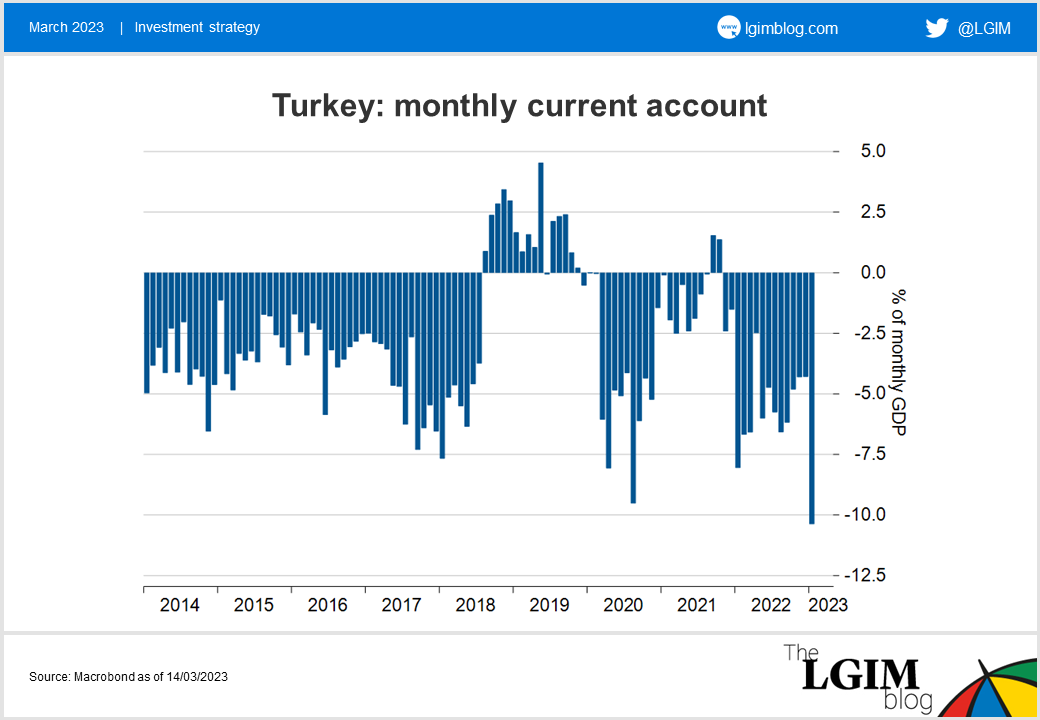Disclaimer: Views in this blog do not promote, and are not directly connected to any L&G product or service. Views are from a range of L&G investment professionals, may be specific to an author’s particular investment region or desk, and do not necessarily reflect the views of L&G. For investment professionals only.
Last tango in Istanbul?
Indicators signal further lira stress regardless of the result in the forthcoming Turkish elections, but timing any market moves is difficult.

Turkey’s forthcoming election, which is expected in May, will take place against a bleak humanitarian and economic backdrop.
The tragic consequences of the 7.8 magnitude earthquake, which struck on the Turkish-Syrian border in early February and led to over 50,000 deaths, are still being felt. Official statistics record inflation at 55%, by far the highest among emerging markets (EMs). For his re-election effort, Recep Tayyip Erdoğan has cranked monetary and fiscal stimulus up to the limit to win over voters.

Throwing the financial kitchen sink at electoral victory has left the economy in a parlous state. The current account deficit was an eyewatering 10.4% of GDP in January, financed by cash injections from the Gulf states and Russia. Political pressure on the central bank to cut rates and support growth has destroyed authorities’ credibility, as inflation has run amok.

Despite the institutional damage, stimulus appeared to have given Erdoğan a fighting chance in the election: the opposition, normally favoured at a time of economic strain, has remained fractious, and stands broadly level with Erdoğan in the polls. Of course, we can’t predict the election’s outcome but are interested in its consequences.
Want to avoid crisis? I wouldn’t start from here
The morning after the election, any government will face the effects of Erdoğan’s re-election efforts. Letting stimulus run wild has produced external imbalances that are unsustainable. Foreign funds that have supported the external balance may soon dry up, and the lira, which has remained broadly stable since October, could resume its depreciatory trend.

Once depreciation starts it is difficult to keep orderly. Removing controls on lira foreign trading (essential to reduce external imbalances) could trigger a sell-off. Lira depreciation harms both Turkish corporates (which have significant dollar liabilities) and the public balance sheet, through a deposit insurance scheme unveiled last year. If these factors compound, they could spell disaster for the Turkish economy.
Living in the moment: timing a possible lira slump
Yet timing a potential lira crisis is tricky. Given the constraints on the offshore lira, investors looking to short the currency must pay steep mark-ups, easing pressure on the currency. While funding from Gulf allies and others will not continue forever, it could persist for some time after the election. Tourism spending, expected in the summer, could also delay a potential crisis. Policymakers may also pre-empt markets, starting a modest depreciation early, to avert pain later.
Though timing currency moves is always hard, we remain alert for signals of a sharp lira depreciation. Looking beyond the short term, while Turkey’s current path is unsustainable, it is endowed with remarkable strengths. A young population, proximity to the world’s largest trading bloc and friend-shoring of global supply chains should support Turkish growth in time.
Any upcoming currency crisis, while challenging, could just be growing pains.
Recommended content for you
Learn more about our business
We are one of the world's largest asset managers, with capabilities across asset classes to meet our clients' objectives and a longstanding commitment to responsible investing.

